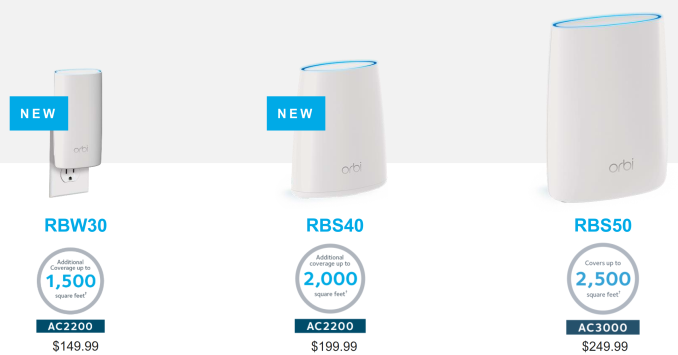Corsair Vengeance RGB DDR4 3000Mhz 32GB Kit Subscribe! http://bit.ly/SubTechofTomorrow Corsair Vengeance RGB LED 32GB (4x8GB) DDR4 3000MHz
http://amzn.to/2nsmsTK http://www.corsair.com/en-us/vengeancergb Try Amazon Prime FREE for 30 Days & Support Tech of Tomorrow! http://amzn.to/12JFYau Don't forget to check out the website!
http://www.techoftomorrow.com Check us out on Facebook!
http://www.facebook.com/TechofTomorrow Stay updated on Twitter!
http://www.twitter.com/techof_tomorrow Tech of Tomorrow Music!
http://www.techoftomorrow.com/music The Benchmark Song: The Human Zoo
– Free on Spotify! http://spoti.fi/10Vz31z
– Amazon: http://amzn.to/12Rh6kI
– iTunes: http://bit.ly/199301I
Categoria: HardwareSoftware

La società di Mountain View presenta un nuovo sito web che raccoglie tutti i progetti sviluppati o direttamente seguiti da Google.
Google ci tiene a rimarcare quanto l’azienda stia investendo su progetti opensource. Ed è per questo motivo che ha deciso di presentare un nuovo sito web – Google Open Source che offre un interessato spaccato sulle attività della società di Mountain View e sul suo supporto alla comunità degli sviluppatori.
Google utilizza soluzioni opensource sin “dalla notte dei tempi”: dai server Linux per arrivare a qualunque riga di codice che viene scritta nell’ambito di qualsivoglia progetto.
L’azienda fondata da Larry Page e Sergey Brin “sponsorizza” i progetti opensource realizzati attraverso realtà come Apache Software Foundation, Software Freedom Conservancy e molte altre.

Il sito presentato quest’oggi raccoglie tutti i progetti a sorgente aperto ai quali i tecnici di Google si sono dedicati e su cui stanno quotidianamente lavorando.
Vengono citati progetti più famosi e ambiziosi come TensorFlow (Machine learning, Google riconosce il contenuto di ogni video), Go e Kubernetes ma anche prodotti più “limitati” come Light My Piano, Neuroglancer e Periph.io.In particolare consultando questa pagina, si ha la possibilità di iniziare un vero e proprio viaggio tra i progetti opensource firmati Google.
Autore: IlSoftware.it
Federal tax rebates in some states will bring prices even lower
Tesla has announced that it is raising $ 1.2 billion to fuel its coming Model 3, an all-electric, entry-level sedan that is set to enter mass production later in July.
The company said in SEC filings last Friday that it raised about $ 350 million via stock sales and brought in an additional $ 850 million in convertible debt. In addition, the company said that stock offerings include $ 250 million of common stock and $ 750 million in convertible senior notes due in five years – in concurrent underwritten registered public offerings.
Underwriters will be given a 30-day option to purchase up to an additional 15 percent of each offering, with CEO Elon Musk participating by purchasing $ 25 million of common stock. The funds will be used to strengthen its balance sheets and “reduce any risks associated with the rapid scaling of its business due to the launch of the Model 3,” as well as for general corporate purposes.
Tesla’s five-seater Model 3 electric sedan accelerates as fast as some of the best-selling “junior executive” luxury sports sedans in the United States, including the Audi A3/S3 and the BMW 2 series. In early prototype runs, Musk said the base Model 3 can do 0 to 60mph in under 6 seconds, or roughly on par with current Audi A3 or BMW 228i models. A later release with a dual-motor option arriving next year is expected to perform in an even slimmer acceleration timeframe, while a right-hand drive option is scheduled to appear sometime next summer.
The state of New York has already begun releasing details of a new EV incentive plan that allows owners of the Chevy Bolt and upcoming Tesla Model 3 to take advantage of a full $ 2,000 rebate program beginning April 1st. The vehicle requirements to receive the full rebate include an MSRP of less than $ 60,000 and a range of over 120 miles. The second requirement will strategically eliminate owners of the Nissan Leaf, BMW i3 or Ford Focus Electric from qualifying for the rebates, though these models will still receive a $ 1,700 rebate despite falling short on range requirements.
The upcoming Model 3 launch later this year is expected to bring the potential base price down to $ 25,500 in the state of New York after federal tax incentives. The company added the Model 3 to appeal to consumers that are not able to afford its six-figure Model S and Model X sedans, which do not qualify under the range requirement.
In addition, Tesla is in the process of building out a billion-dollar Gigafactory battery plant in Nevada approximately 455,225 square meters (4.9 million square feet) that will house facilities used in the manufacture of its PowerPack 3 and PowerWall 2 battery units, along with battery packs for Model 3 vehicles. The Nevada plant is expected to bring in another $ 350 million to the state and at least 550 more jobs to the region. On its own, Gigafactory 1 is expected to employ roughly 6,500 people by 2022. This type of job generation and investment is creating healthy competition among European nations that are eager to be part of Tesla’s Gigafactory 2 endeavors.
Back in December, Dutch Economy Minister Henk Kamp announced to parliament that the government would strive to convince Tesla to build its second Gigafactory operation in the Netherlands to “strengthen the automotive sector in Noord-Brabant and other regions” of the country. While the current regional office is located in Amsterdam, Musk has stated that in the long term, “there is no question” that Europe will receive at least two or three battery factory locations as investment begins to shape and supply begins to ramp up for more factory production.
Autore: Fudzilla.com – Home

Sino a pochi anni fa i sistemi desktop assemblati dai grandi produttori internazionali erano unicamente destinati all’utilizzo in ambiente da ufficio, lasciando alle proposte assemblate in proprio o dai negozianti i componenti più potenti dedicati agli appassionati. Più recentemente il mercato, inizialmente in modo timido e in seguito con sempre maggiore vivacità, ha optato per proporrte sistemi desktop di dimensioni e caratteristiche tecniche differenti tra di loro ma tutti orientati ad un ben specifico target di utenti, quello dei videogiocatori.
[HWUVIDEO=”2314″]Asus ROG GR8 II: mini PC da gaming[/HWUVIDEO]
Partendo da una considerazione molto semplice, quella che la diffusione del gaming in ambiente domestico è aumentata nel corso degli anni anche grazie alla presenza nei salotti di console collegate al televisore, è evidente come anche un PC possa venir utilizzato quale piattaforma di questo tipo andando a sostituire quella che è una console. Ecco quindi la necessità di avere sistemi esteticamente gradevoli, se possibile originali nel design ma in grado di integrare al proprio interno quei componenti che li rendano adatti alle necessità dei videogiocatori.
E’ a partire da questa logica che Asus ha sviluppato la famiglia di prodotti indicata con il nome di GR8, appartenenti alla propria famiglia ROG, Republic of Gamers. Si tratta di PC compatti che non utilizzano la GPU integrata nel processore ma si servono di una scheda video dedicata, così da offrire superiori prestazioni complessive e garantire una esperienza di gioco adeguata. I modelli ROG GR6 e GR8 utilizzano uno chasis da soli 2,5 litri di volume complessivo, senza però per questo rinunciare ad una scheda video dedicata. Con il nuovo modello ROG GR8 II, analizzato in questo articolo, Asus aumenta leggermente il volume sino a 4 litri cambiando il design esterno e soprattutto aprendo spazio all’utilizzo di componenti ben più potenti.
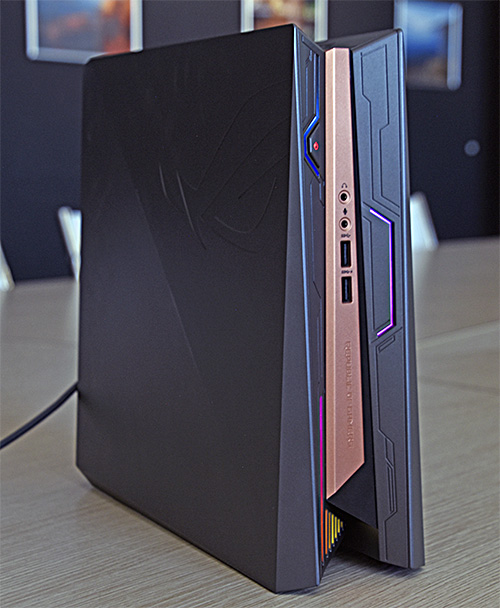
Troviamo infatti processori Intel Core delle famiglie i7 e i5, in declinazioni non destinate a notebook ma desktop tradizionali con TDP massimo pari a 65 Watt, abbinati ad una scheda video NVIDIA GeForce GTX 1060 con un quantitativo di 3 Gbytes di memoria video. Sulla carta questi componenti assicurano potenza di calcolo tale da garantire frames al secondo medi sempre più che adeguati alla risoluzione Full HD, oltre che una adeguata riserva di potenza con applicazioni di produttività personale. Nella tabella seguente abbiamo riassunto le principali specifiche tecniche complete di questo sistema.
|
specifiche |
Asus ROG GR8 II |
| processore | Intel Core i7 7700 |
| chipset | Intel H110 |
| scheda video | NVIDIA GeForce GTX 1060 3GB |
| memoria | 2x8GB DDR4 2400 |
| storage | 256GB SSD |
| rete | ethernet Intel 1 Gpbs Wi-Fi 802.11ac, 2 channel MIMO |
| dimensioni | 88x299x281,3mm |
| peso | 4Kg |
| connessioni | 2xUSB 3.0 1xUSB 3.1, Type A 1xUSB 3.1, Type C 2xHDMI 1xDisplay Port 1xEthernet RJ45 1xOptical S/PDIF 1xAudio Jack |
Il marchio ROG, Republic of Gamers, è utilizzato da Asus per identificare i propri prodotti destinati ai videogiocatori più appassionati. Questo brand pertanto identifica sistemi con un target di riferimento ben specifico, con i quali non sono vengono scelti componenti adatti ai videogiocatori ma nei quali sono implementate soluzioni tecniche molto particolari. Abbiamo già parlato delle dimensioni contenute, che di fatto rendono ROG GR8 II comparabile per ingombro ad una delle console disponibili in commercio; queste non implicano però un funzionamento rumoroso grazie alla divisione del volume interno in due distinte partizioni, dedicate rispettivamente una alla scheda video e l’altra alla scheda madre con processore e storage. In questo modo il calore prodotto dai componenti presenti in queste due partizioni viene espulso all’esterno senza che vada a interferire con l’altro blocco interno dello chassis, evitanto in questo modo che alcuni componenti possano indirettamente far aumentare la temperatura di funzionamento degli altri.
Sistema compatto, quindi rumoroso? Asus ROG GR8 II ci ha positivamente sorpreso in questo senso: il rumore delle ventole è percepibile quando CPU e scheda video sono sfruttate al massimo delle potenzialità, ma non in modo da risultare fastidioso. In idle il sistema si avverte appena, replicando in questo il comportamento tipico di una console da gioco. Trattandosi di un sistema dedicato ai videogiocatori non possono mancare i LED RGB, di fatto quello che è diventato l’accessorio per eccellenza in questo tipo di sistemi e che in alcuni casi porta a risultati che sono oggettivamente eccessivi. Il tutto è configurabile da pannello software Asus Aura, direttamente da sistema operativo: è addirittura possibile mantenere i led in funzione anche quando il sistema viene spento, ma le opzioni a disposizione sono le più disparate e più di tutto è possibile ovviamente anche tenere i led spenti del tutto.
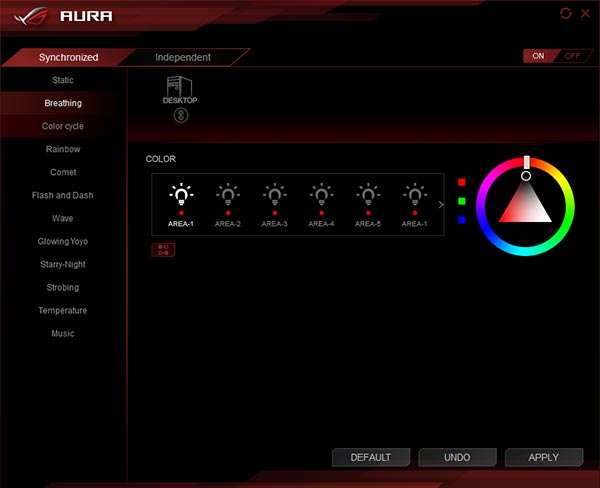
pannello di controllo AURA per la gestione dei LED RGB
Aprendo il sistema, agendo sul pannello laterale, è possibile intervenire ad espandere la memoria di sistema e la soluzione di storage. La prima è basata su moduli So-Dimm, gli stessi utilizzati nei sistemi notebook così da contenere l’ingombro complessivo, per una capacità massima che può raggiungere i 32 Gbytes. Per lo storage troviamo un SSD in form factor da 2,5 pollici, da 240 Gbytes di capacità, che può essere affiancato da una seconda unità di storage con interfaccia M.2 presente sulla scheda madre. L’utente può in alternativa sostituire l’SSD da 2,5 pollici in favore di un hard disk di pari dimensioni, più lento ma con capienza nettamente superiore. L’interfaccia dell’SSD è quella SATA, che garantisce circa 550 Mbytes al secondo in lettura e poco più di 260 Mbytes al secondo in scrittura.
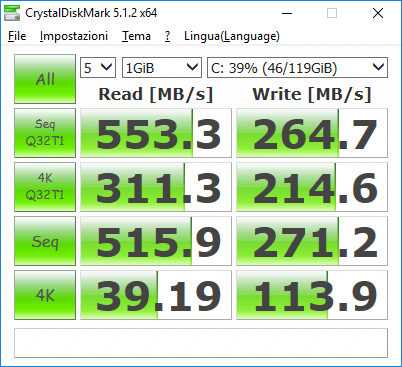
prestazioni dell’SSD integrato nel sistema
Il processore scelto da Asus per questo sistema è modello Core i7 7700, proposta con architettura quad core capace di gestire sino a 8 threads in parallelo. La frequenza di clock di default è pari a 3,6 GHz, con un dato di boost clock che ariva a 4,2 GHz in single threaded e sino a 4 GHz utilizzando in parallelo tutti i core.
Completa la dotazione onboard di questo prodotto il sottosistema audio, quello Supreme FX che Asus adotta anche in molte proprie schede madri della famiglia Republic of Gamers. La rete Wi-Fi onboard è ovviamente di tipo dual band, compatibile con la tecnologia MIMO e capace di un transfer rate che raggiunge quale massimo teorico un valore di 867 Mbps. Le due antenne sono integrate nella parte superiore dello chassis, incastonate in modo tale da evitare interferenze con gli altri componenti presenti nel sistema.
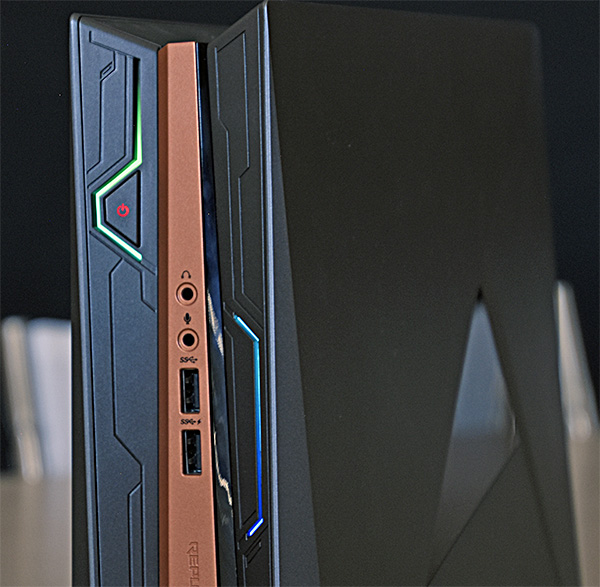
L’utilizzo di una scheda video NVIDIA GeForce GTX 1060 con 3 Gbytes di memoria video rende questo sistema compatibile, sulla carta, con un utilizzo in abbinamento ad uno dei visori per la realtà virtuale presenti sul mercato. Quello della compatibilità VR è un tema molto sentito dai produttori di sistemi in quanto uno strumento molto utile ai fini della promozione marketing dei propri sistemi, per quanto la diffusore di visori VR sia al momento non così elevata come ci si poteva inizialmente attendere.
|
CPU |
Intel Core i7 7700K | Intel Core i7 7700 | Intel Core i5 7600K | Intel Core i3 7350K |
| Povray 3.7.0 | 2.087 | 1.565 | 1.644 | 1.000 |
| Cinebench 15 | 967 | 741 | 672 | 458 |
| Blender 2.78 | 444 secondi | 572 secondi | 647 secondi | 934 secondi |
| Corona benchmark 1.3 | 226 secondi | 279 secondi | 366 secondi | 462 secondi |
| 7-zip 16.04 x64 | 26.930 | 21.343 | 18.295 | 13.249 |
| Handbrake 1.0.2 – 64bit H.264 | 19 fps | 15,9 fos | 14,6 fps | 9,2 fps |
| Handbrake 1.0.2 – 64bit H.265 | 10,5 fos | 9 fps | 8,4 fps | 5,1 fps |
| Luxmark 3.1 – OpenCL CPU | 508 | 477 | 644 | 298 |
| Hybrid – H.265 first pass | 25,9 fps | 20,8 fps | 21,4 fps | 13,2 fps |
| Hybrid – H.265 second pass | 24,6 fps | 18,5 fps | 19,4 fps | 11,8 fps |
In termini di produttività personale il sistema Asus ROG GR8 II mette a disposizione una potenza di calcolo che è decisamente adeguata per i tipici utilizzi di un PC desktop in ambiente domestico. Le prestazioni sono molto vicine a quelle del PC di riferimento basato su processore Intel Core i7-7700K, versione di CPU che ha frequenze di clock superiori al modello Core i7-7700 adottato dal mini-PC di Asus. Nulla da rimpiangere quindi quanto a componenti scelti per le tradizionali applicazioni personali: il sistema risponde in modo pronto e rapido ai comandi e assicura valide prestazioni anche con ambiti particolarmente
La potenza di calcolo messa a disposizione dal sistema Asus ROG GR8 II è tale da assicurare valide prestazioni velocistiche alla risoluzione di 1920×1080, o Full HD. La scheda GeForce GTX 1060 3GB, in abbinamento al processore Intel Core i7-7700, garantisce livelli di frames al secondo più che adeguati anche con impostazioni qualitative molto spinte. Di seguito i risultati, in termini di frames al secondo medi, ottenuti con alcuni titoli utilizzando impostazioni qualitative particolarmente spinte.
|
titolo |
fps medi – 1920×1080 pixel |
| Ashes of the Singularity | 46,2 fps |
| Rise of the Tomb Raider | 51,7 fps |
| Deus Ex: Mankind | 50,1 fps |
| Hitman | 103,4 fps |
| Shadows of Mordor | 84,4 fps |
| Alien | 141,7 fps |
| F1 2016 | 63 fps |
I dati registrati sono molto validi, in considerazione delle impostazioni qualitative spinte che sono state selezionate. La potenza di calcolo della scheda GeForce GTX 1060 3GB non è a nostro avviso adatta a pilotare display con risoluzione più elevata; uno scenario d’uso domestico che si può ipotizzare è quello di abbinare Asus ROG GR8 II ad un televisore di grande diagonale e risoluzione Full HD, così da fornire una esperienza di gioco di massimo intrattenimento anche in salotto.
[HWUVIDEO=”2314″]Asus ROG GR8 II: mini PC da gaming[/HWUVIDEO]
Il prezzo di Asus ROG GR8 II, nella configurazione testata in queste pagine, è pari a circa 1.300€ IVA inclusa; è possibile optare per una configurazione più semplice quanto a processore con il modello Core i5 7400 (architettura quad core senza tecnologia Hyper-Threading, clock di 3 GHz e boost clock sino a 3,5 GHz) rinunciando a qualcosa in termini di prestazioni velocistiche assolute. Si tratta di un sistema che viene proposto a quegli utenti che desiderano un PC per il gaming pronto all’uso, dalle dimensioni compatte ma caratterizzato da un design personale e dall’effetto visivo ben evidente. Per chi vuole un’alternativa ad una console, senza compromessi quanto a prestazioni velocistiche e con la flessibilità tipica dell’amibiente PC, Asus ROG GR8 II è una opzione d’acquisto particolarmente interessante.
Autore: Le news di Hardware Upgrade


Netgear introduced their first product in the Wi-Fi system / mesh category, the Orbi, in August 2016. Its dedicated wireless backhaul (4×4 802.11ac / 1733 Mbps) and 2×2 radios with MU-MIMO support for the clients (on both the router and the satellite) made it one of the best performing Wi-Fi system kits in the market. Since the introduction of the Orbi RBK50 (AC3000), various vendors in the Wi-Fi market have come with their own variants. The increasing competition has turned out to be good for consumers, resulting in kits getting introduced at very competitive price points.
Many mesh systems come in packs of three, but, Orbi stood out with its claim of being able to blanket a 4000 sq. ft house with just a router and a satellite. Despite the high price (mainly due to additional hardware, compared to a regular router), mesh / Wi-Fi systems have been enjoying very good market reception. In order to tackle the increased competition (often coming in at a lower price point compared to the Netgear Orbi RBK50 kit), Netgear is introducing two additional members in the Orbi family – the RBK30 and RBK40. Like the RBK50, the main unit and the satellite in the RBK40 are similar in appearance and available interfaces. However, the physical dimensions of the RBK40’s components are smaller than that of the RBK50. The RBK40 and the RBK30 share the same router, but, the satellite in the latter is of the wall-plug variety and has no wired ports. The other differences between the three are summarized in the table below.
| Netgear Orbi Kits (Q1 2017) | |||
| Aspect | RBK50 | RBK40 | RBK30 |
| Class | AC3000 | AC2200 | |
| Backhaul | 4×4 802.11 ac (1733Mbps) | 2×2 802.11ac (866 Mbps) | |
| Clients | 2×2 802.11bgn/ac (400Mbps + 866 Mbps) | ||
| Wired Configuation (Router) | 1xWAN + 4xLAN GbE Ports | ||
| Wired Configuration (Satellite) | 5x GbE Ports | None | |
| Launch Date | Aug. 2016 | Mar. 2017 | |
| Launch MSRP | $ 400 | $ 350 | $ 300 |
Netgear is able to reach these lower price points due to the following changes compared to the RBK50:
- Replacement of the 4×4 backhaul radio with a 2×2 one (AC3000-class to AC2200-class) in both the RBK30 and RBK40
- Updates to the power amplifiers to meet the lowered range requirements in the RBK30 and RBK40
- Removal of the 4-port wired switch in the RBK30’s satellite
During the press briefing, Netgear emphasized that they support both PC-based and mobile app-based setup for the Orbi. Particular stress was also made on the ability of the Orbi kits to operate effectively without any reliance on the cloud (unlike products such as the Google OnHub that have encountered various issues due to over-reliance on the cloud for day-to-day operation).
Netgear is also making the satellites available for purchase separately. The price points for these extenders range from $ 150 for the wall-plug variety to $ 250 for the one with the 4×4 backhaul link.
The new Orbi products also use the same Qualcomm Atheros IPQ4019 network processor SoC, along with the Wi-Fi SON features. While retaining the same feature set, the RBK30 and RBK40 expand the target market for Wi-Fi systems. The lower price points will also help Netgear in tackling the increasing competition.
Autore: AnandTech

